Likya Yolu – Hiking the Lycian Way
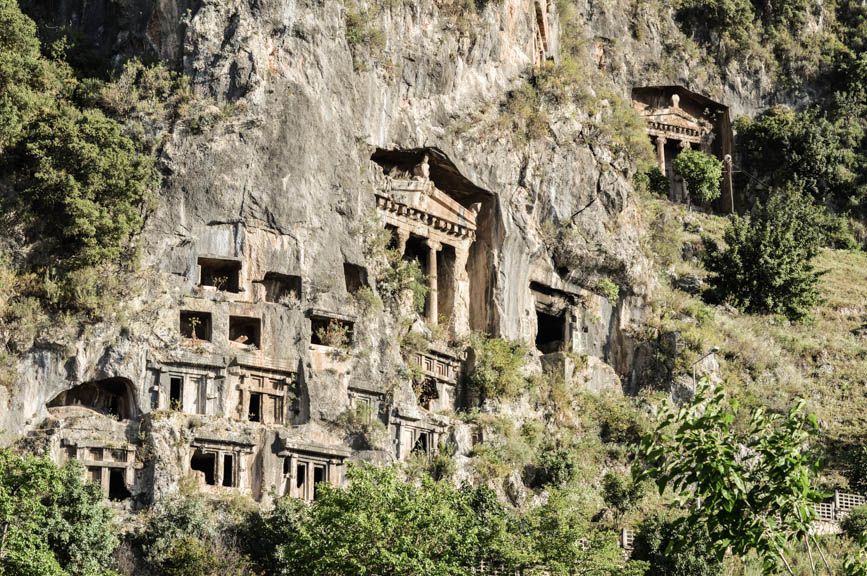
So far on our journey, we have generally proceeded without too much planning, not sure of where we will go next, when, how we would get to our next destination, happy to follow the unexpected. There are a few exceptions to this and one of them was the Lycian Way. One of our favourite methods of discovering a region is trekking, in most places it is a great way to escape the crowds, see stunning landscape and meet locals. Once we knew we would be going to Turkey, we knew that this trek, the first long-distance footpath created in Turkey would be on our must-do list. There are now a few more long distance treks in the country, including the Phrygian Way and St Paul’s Trail, all of which follow the footsteps of ancient civilisations and historical figures.
The Liyka Yolu, the turkish name for the trek, is a 500km path spanning the South-western coast of Turkey from Fethiye to Antalya. It follows the tracks of the ancient Lycian people, known for their strength and independence. The Lycians were based in the Teke peninsula and are well-known for setting up one of the first truly democratic systems called the Lycian League; a fluid confederation of about 23 states in 168 BC when they were granted independence from the Roman Empire.
The full trek takes around 25 days, which was too much for us, but the part running west to east from Fethiye to Kas is famous for having some of the most beautiful views and beaches and if you go in this direction, around day 4 to 5 you will hit the sites that would delight any history buff, the ancient towns of Xanthos and Patara.
The official starting point is at the top of the valley near Ovacik, a 10-minute dolmus (dol-moosh – minibus) ride from Fethiye. However, there is also a new section from Fethiye, not far from the impressive rock tomb of Amyntas – son of Hermagios built into the cliff-side. There is a Chinese saying that claims the best place to be buried is “背山面海“ – with mountains behind and the sea in front, this guy definitely has the best spot in town.
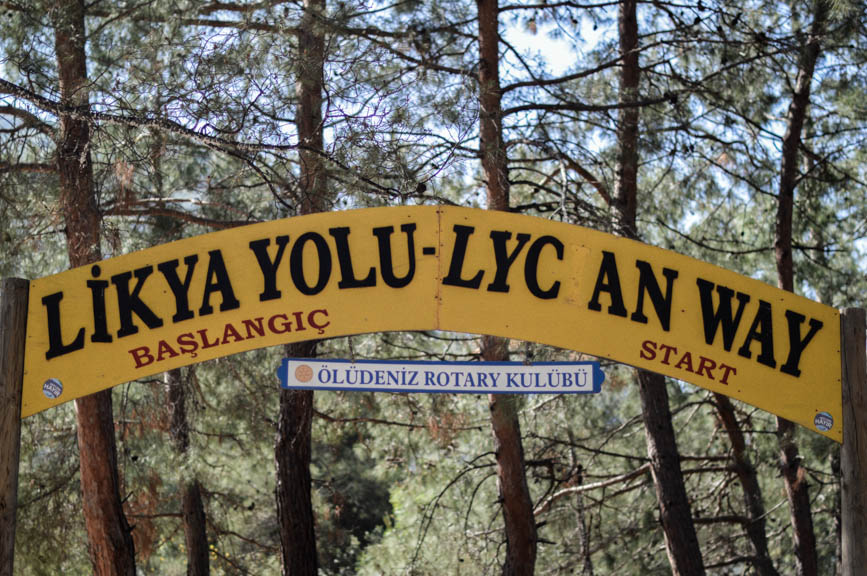
Day #1 Ovacik – Kozağaç – Kirme – Faralya
Off we go, adrenaline and excitement running through our veins, we hop off the dolmus at the round-about in Ovacik, our bags stocked with dried fruits and nuts from the market and ask around for the Likya Yolu until we find the great big yellow sign welcoming us to our route for the next few days. Five minutes later, we are quite convinced we have already taken a wrong turn, there isn’t a white/red stripey sign in sight…but we persevere and a sign appears! Welcome to the Lycian Way. We quickly discover that there was no need to worry, over the next few days, while at times it may not be the most precisely indicated route, the white and red stripey signs, painted by dedicated volunteers, will always show up to reassure you.
The rocky path from Ovacik to Kozağaç follows the gorgeous coastline right under the imposing peak of BabaDaği where numerous paragliders jump off to get a birds’ eye view of the famous beach of Olüdeniz. The turquoise waters are just out of reach, extra inviting in the sun-scorching heat. A beautiful way to start the trek.
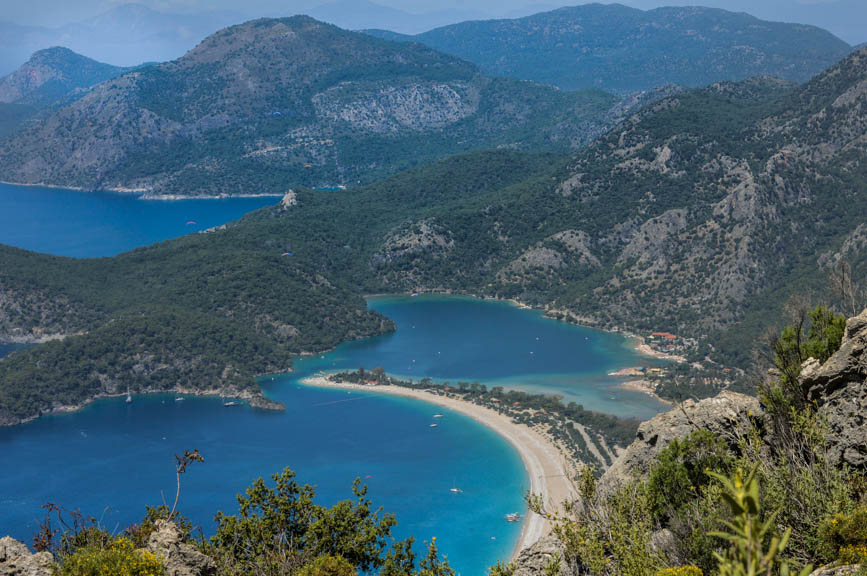
After several hours we arrive in Kozağaç, a little hamlet snuggled in a small valley among the sky-high mountains. At the entrance of the village we find Erdal and his wife Ouznush preparing Gözleme (turkish pancakes) and hot kahve (coffee) and çay (tea); out go our plans for a crackers n’ cheese picnic. We sit down and watch Ouznush efficiently roll out the dough of the gözleme onto one of those tailor-made wooden circle stands where all gözleme-making we have seen so far takes place. The dough is rolled around the rolling pin, then released swiftly and gently onto the board, each time getting slightly thinner. This is done at blinding speed and as what is usually the case with these kinds of crafts, it looks so easy. Ouznush is graceful enough to let me try and of course it requires years of training to make the dough look weightless as I clumsily make numerous creases in her perfect sheet. Another item on my list of culinary skills to perfect.
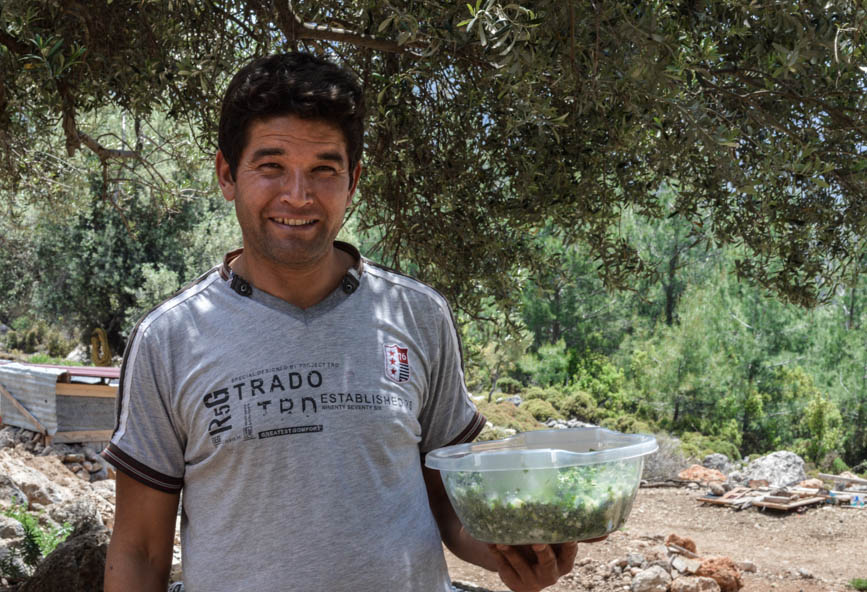
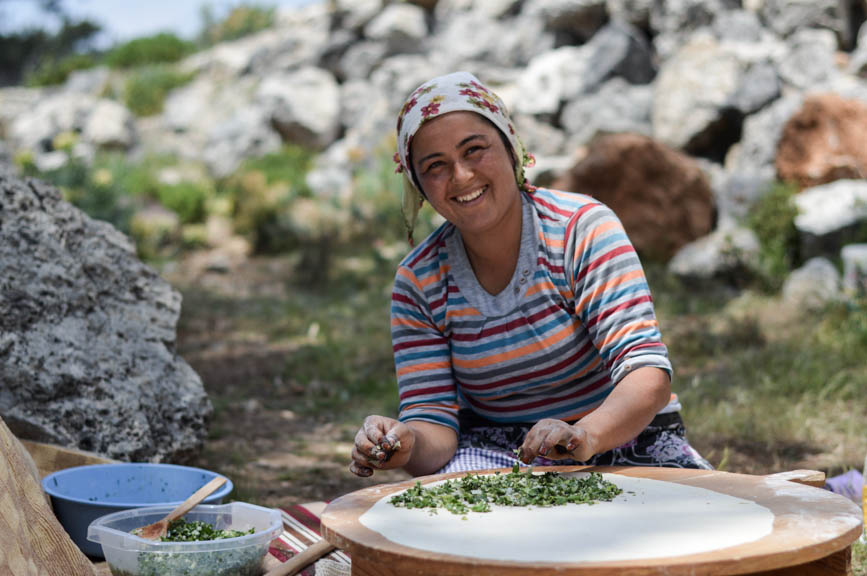
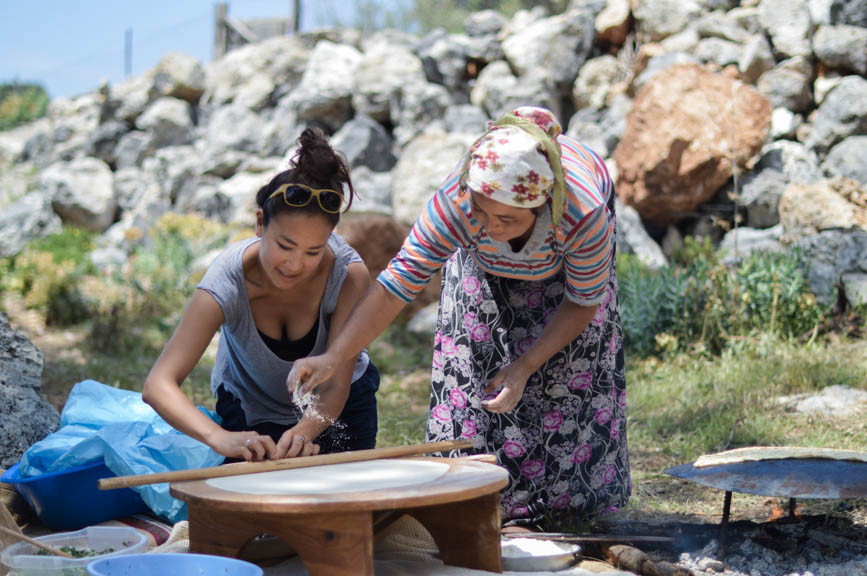
The spinach-filled gözleme are as delicious as they look and smell and we leave happy and full, our bags still stuffed with food to continue our way.
We round Kirme and the valley of Faralya just as the raindrops begin. The weather swiftly changes as the clouds thunder in and echo between the slopes. Each thunder seems to carry on forever as it is bounced off repeatedly among the rocks. Suddenly we are surrounded by grey. But the sun fights back and we are gifted with a dewy golden view over the Butterfly Valley, a deep gorge dropping into yet another stunning beach. Not bad for the first day.
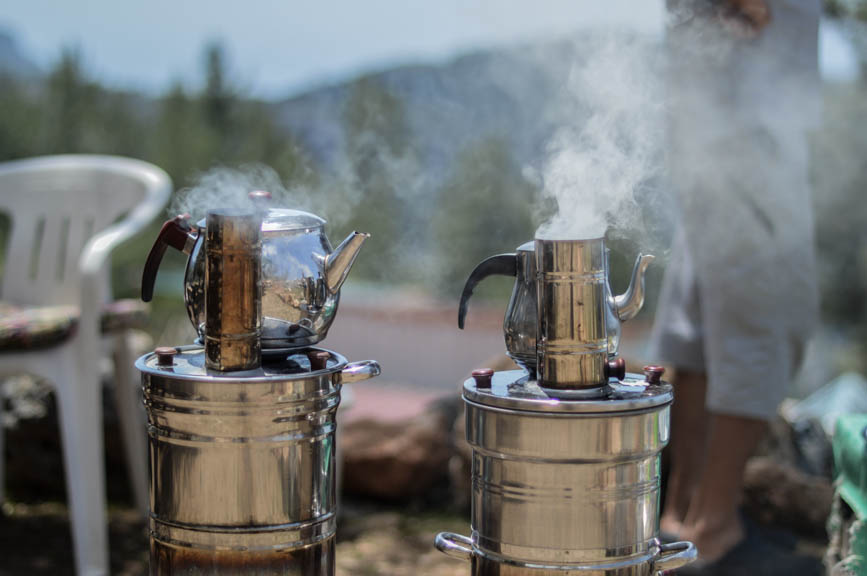
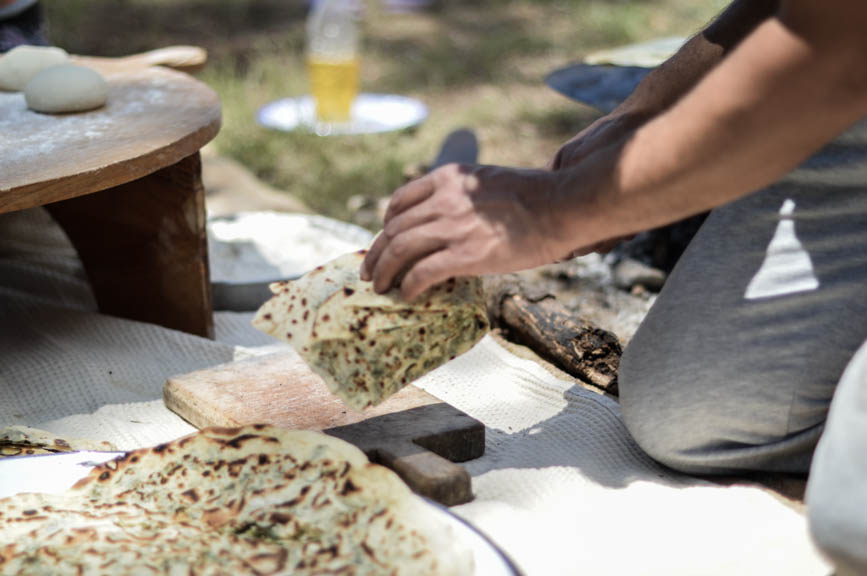
Day #2 Faralya – Kabak
The next day we take it easy and set off for the hippy valley of Kabak. It is a short 3h hike from Faralya, but since it was one of the few accessible beaches on the trek, we decided to take a day off and stop here to enjoy the sea. Kabak is yet another picturesque valley dropping steeply into the Aegean Sea. As we walk down the thousands of steps and mini paths leading into the valley’s belly, the thought that at some point we are going to have to hike back up crosses my mind. Kabak exudes a chilled-out vibe like nowhere else we have been to so far in Turkey, reminding us more of beach towns in India or Thailand. You are entering the yoga and meditation zone – camps are named after Shiva, Shamba, Sultan, Reflections etc. We find a bungalow community to settle in and go off to explore the beach. I say community, because even though they are run as guesthouses, you are never really sure who is working there and who is just hanging out. This is the kind of place where I would have dreamed of settling into for a couple of months in my teenage backpacking days, though for now I was happy to soak in the amazing views from the open-air terrace.
Our beach session did not last long as the biggest storm we have had on our trip so far rushed in to soak the valley. We went to bed that night listening to the torrential rain on the rooftops and hoping for some sun for the rest of our trek.
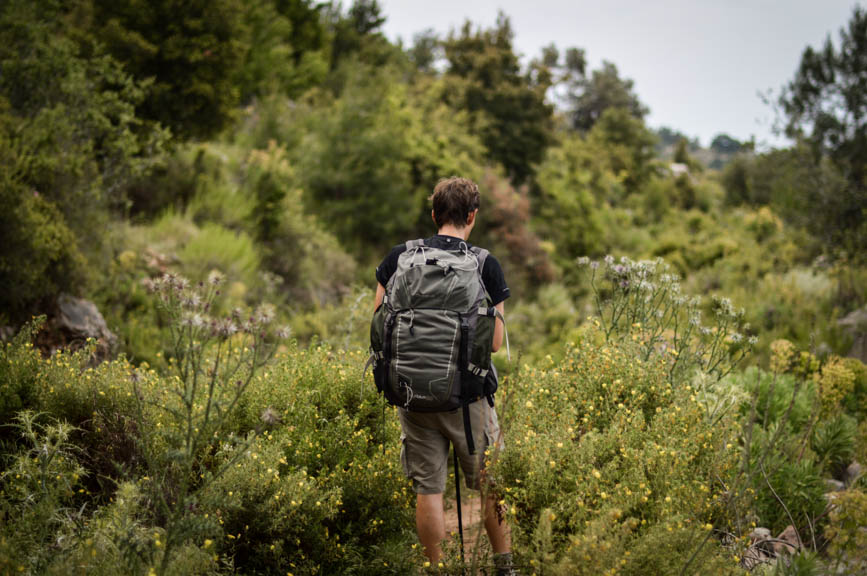
Day #3 Kabak – Alinca
Our morning consisted of playing a waiting game with the continuing downpour and a moment of decision the second it let up. To continue or not continue? The weather forecast was not encouraging for the next week and the deep valley of Kabak does not fair well in rain, but we are determined trekkers so off we go. The steep hill welcomed us back with open arms, but we were grateful the clouds thinned out and we zipped up with ease.
We followed the signs around the top of the valley to our next stop of Alinca. The 5-hour hike climbs and climbs and climbs into the misty clouds. While it is not the sunny and piercing blue coast we have had for the past few days, there is extreme beauty in the eeriness of the dark silent pine trees floating amongst the white fog. The landscape reminds us of a Chinese painting as we finally reach a plateau where the hamlet of Alinca reigns.
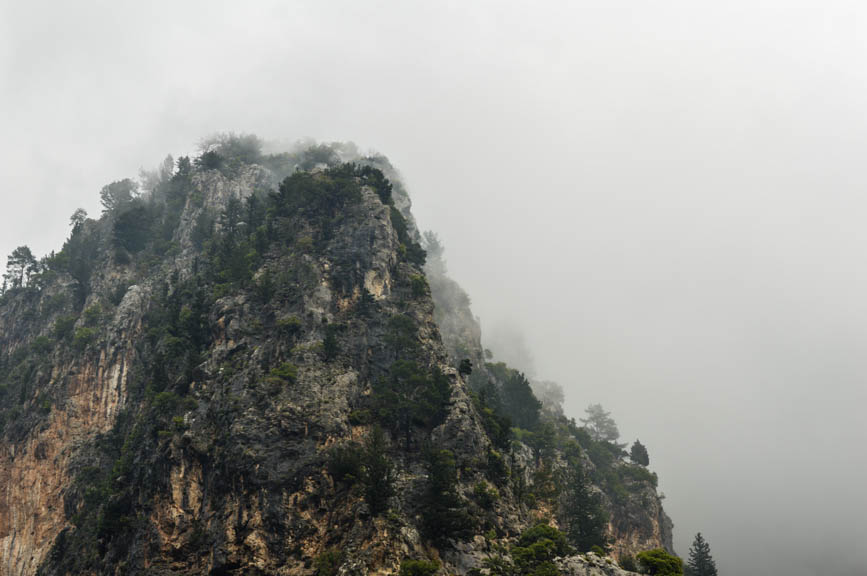
In Alinca, we encounter Serhat and her husband Omer who have built a couple of bungalows perched on the edge of their garden serving as a quaint pansiyon with a view over the cascading cliffs. Trekking makes you appreciate all the small things in life ten times over – hot water (ah!), clean clothes (ah!), hot food (ah!), a clean bed (thank you, thank you, thank you). Throw in delicious home-cooked food, the good company of L & S – fellow trekkers we had met in Fethiye, and our lovely turkish hosts – I could pass out from happiness. We devour Serhat’s steaming hot tomato soup, which seems to be a staple in turkish homes; tavuk (chicken) with tomato and pepper sauce, yoghurt with herbs and cucumbers – a turkish version of tzatziki and fasulye (beans) with tomato sauce. We eat animatedly discussing the route with our new friends, when we pause and praise Serhat for her delicious cooking and she laughs saying that watching us is like watching theatre. Our lack of turkish language skills frustrates us and we are determined to pick up a few more words on the way, so our language class starts here. Serhat runs us through the basics beyond thank you and hello, numbers one to ten and our personal favourite – eeeee-geh-jer-leer – goodnight.
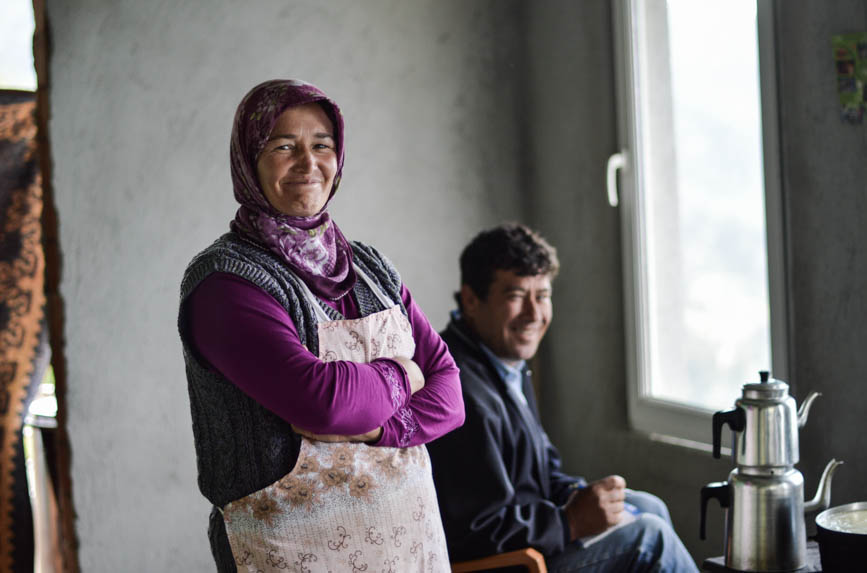
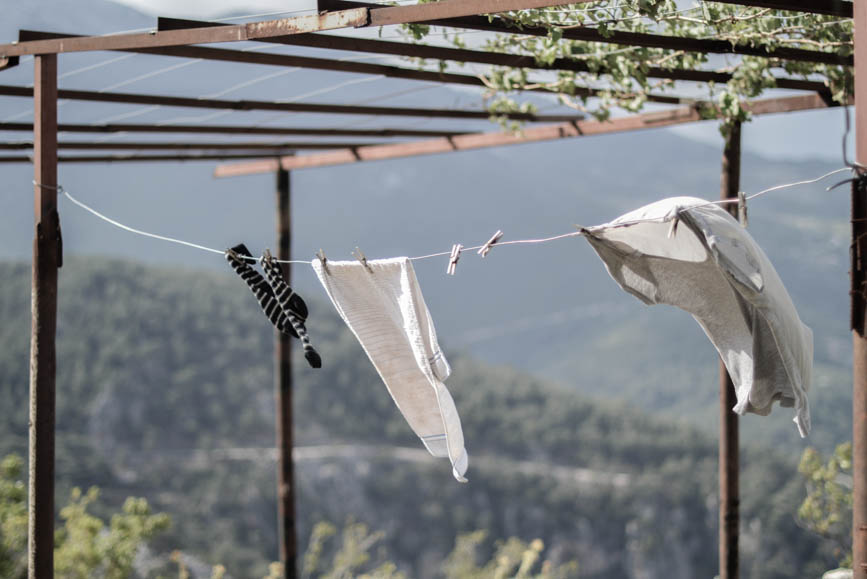
Day #4 Alinca – Gey – Bel
The little window out of our mini-bungalow looks out onto the cliff below Alinca and this morning, the sun is peaking through the clouds, slowly waking up with us. Fuelled by Serhat’s big breakfast we gear up and follow the sign to Gey. The path descends quickly along the rocky mountain side, just hanging on tightly enough not to collapse. It is now clear why they say it would be dangerous to do in bad weather, quite a few rocks are big slabs of eroded flatness that would be difficult to grip on to in the rain. The view is magnificent. Every day the scenery and vegetation has been so different, today there is moss, small thorny shrubs and olive-looking trees that I wish I could name. All sprouting through the thick rock cover that plunges further into more turquoise coves. Following the mountain-side for a few more hours at about 600m above the sea, left me thinking, I need to come back here by boat.

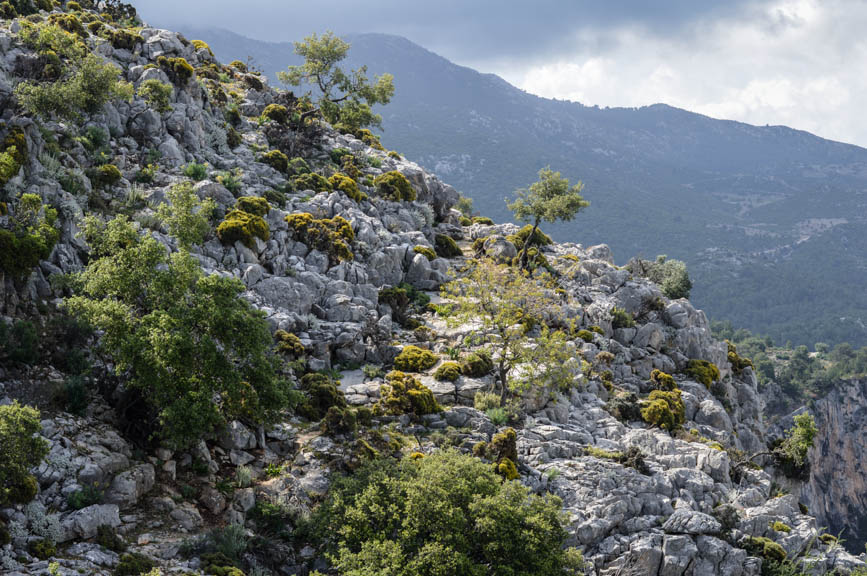
Between Alinca and Gey we arrive at a flat area the colour of golden wheat. This time, olive trees and pines give shade to an old abandoned hammam and you wonder what might have been there before to have this old dome-shaped rock structure in the middle of a cereal field. The muezzin’s call to prayer accompanies us through the plain, echoing like thunder through the valley. There is not a mosque in sight, but the acoustics of the valley transports the powerful and enchanting voice. After a quick break in Gey, we head on to Bel. The wind is up now and the colour of the sea turns from turquoise to a dark blue grey, the surface a brush-stroke opaque from the wind blowing over it. We grip tightly to the rocks along the steep edge as goats merrily run up and down with ease and occasionally take a break from chewing leaves to stare up at us wondering what we were doing at their lunch spot. One of our missions every day was to find our best lunch spot and about a kilometre from Gey we found it, straddled between two big bays on the hilltop, we had our crackers and bal (honey).
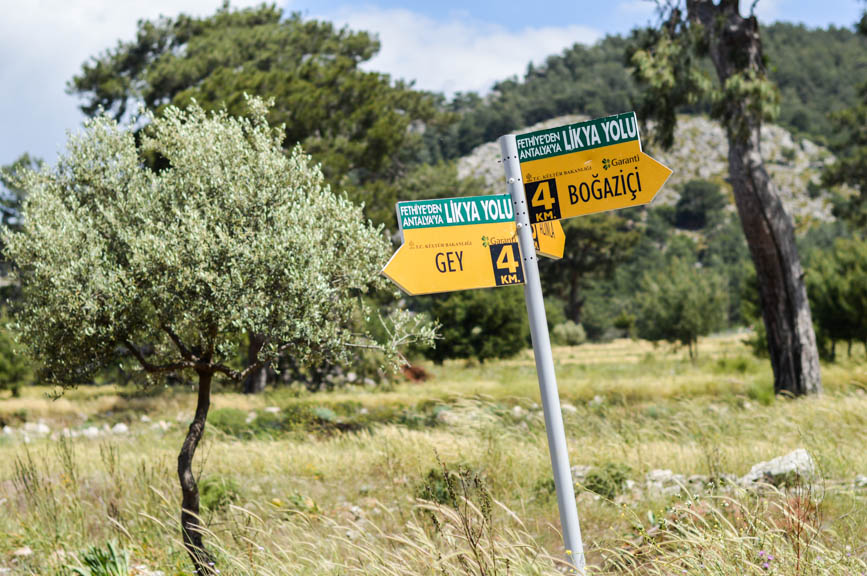
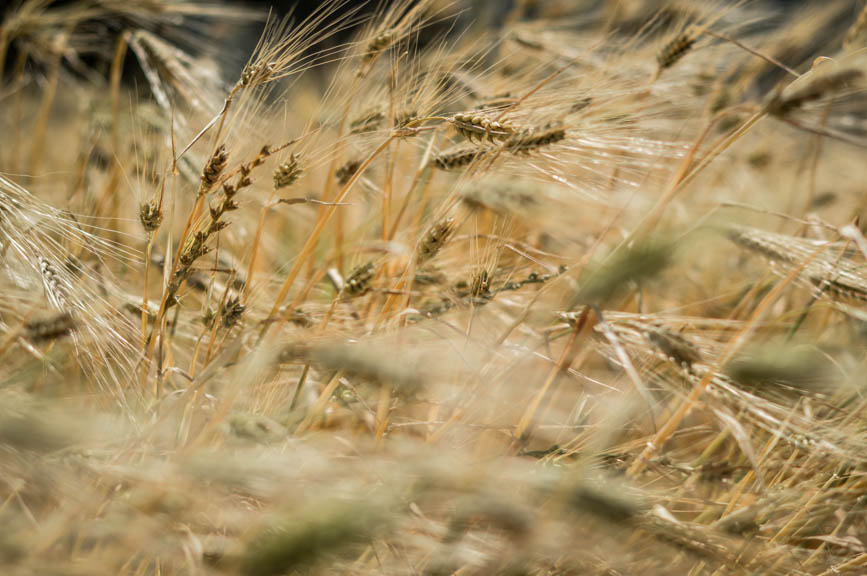
Once we approached Bel we were greeted by a lady in a bright purple top and a colourful orange-blue headscarf – Fatima. Fatima suggests we sleep at her place and after hours of climbing uphill we happily accepted. Fatima’s place is hard to miss as upon entering the village, numerous graffiti marked walls of abandoned houses announce the way to Fatima’s Pansiyon. We enter a gate and pass a few “hard-on-the-eyes” turkeys wandering freely in the garden, to the two little rooms that Fatima has prepared for guests in the her house. Fatima runs her house with a motherly iron fist – you have to make sure you enter the house and exit into the garden with the correct slippers, she gestures and waves around the purple slippers then the blue slippers until she is sure we have understood. Most turkish households remove their shoes before entering and this was no exception, it was nice to feel like we were being integrated into a home for a night. She welcomes us with home-made börek and çay and we could not be happier to have another hot shower.

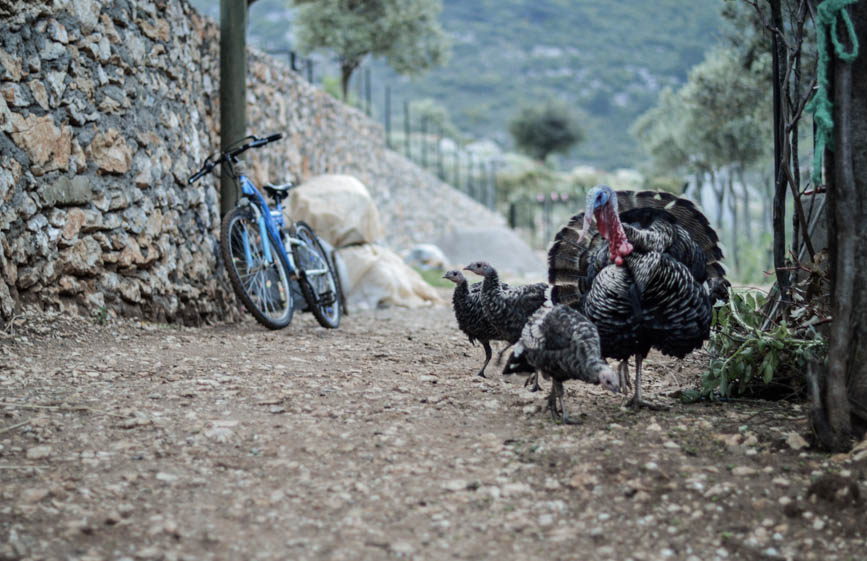
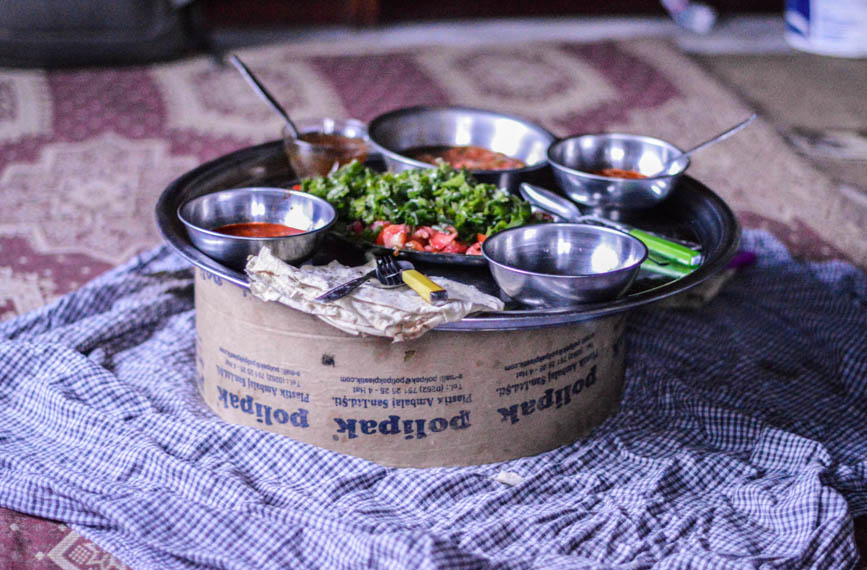
We dine with Fatima’s family with no tourist frills attached, this was the first time that felt like we were eating exactly what they were. The set up in many homes is a round metal tray laid on top of a round platform supported by a short cylinder and you pull the tablecloth onto your crossed legs to make sure you do not spoil the floor. We start with a tomato soup and a stack of Fatima’s daily home-made bread similar to Lavash (unleavened flat bread). This is followed by a hot spicy tomato sauce and salad which consists of more tomatoes and herbs. Turkish cuisine is full of herbs and most home gardens we passed on the way have rows of spring onions ready to be wrapped in flatbread and eaten plain. Dessert is a small pot of honey that everyone takes a spoon from. When Fatima asks us what time we want breakfast and we lazily try for 9am, she laughs incredulously and says that is lunch time, so 8am it is.
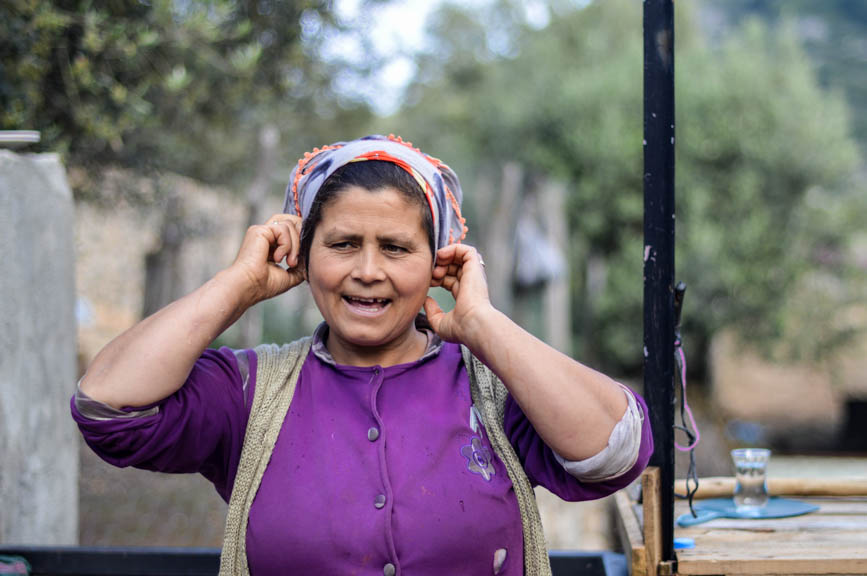
Day #5 Bel – Gavuragli – Pidnei – Letoon – Kinik – Gelemiş
We crawl onto the warm kitchen floor at 8am for breakfast, everyone is already round the table, legs folded under the tablecloth slurping their vermicelli soup. We join them and finish the soup we are given, plus a few pieces of bread with bal. We down our strong sugary çay and take the road again waving to Fatima eagerly as her terrace disappears from view.
The walk from Bel is an easy one, flat for 4km bordered by a vast valley then down a rocky hill once again till you reach the ghost town of Gavuragli. While the other hamlets we passed showed some sign of life, there is a mystery behind Gavuragli that we cannot solve. A beautiful location on the coast, with a few beach coves easily accessible and abundant spring water, yet only abandoned houses. Mmmm. Here we meet L & S again and we cannot resist the call of the waves further down the road. Two hours later we emerge from our private beach, refreshed from the icy dip in the sea, a little more tanned and relaxed from our nap on the huge uncomfortable pebbles.
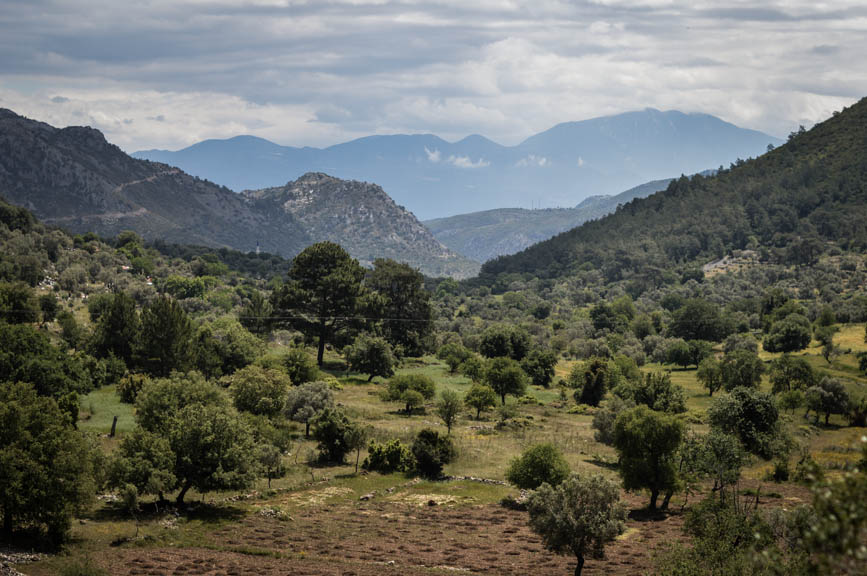
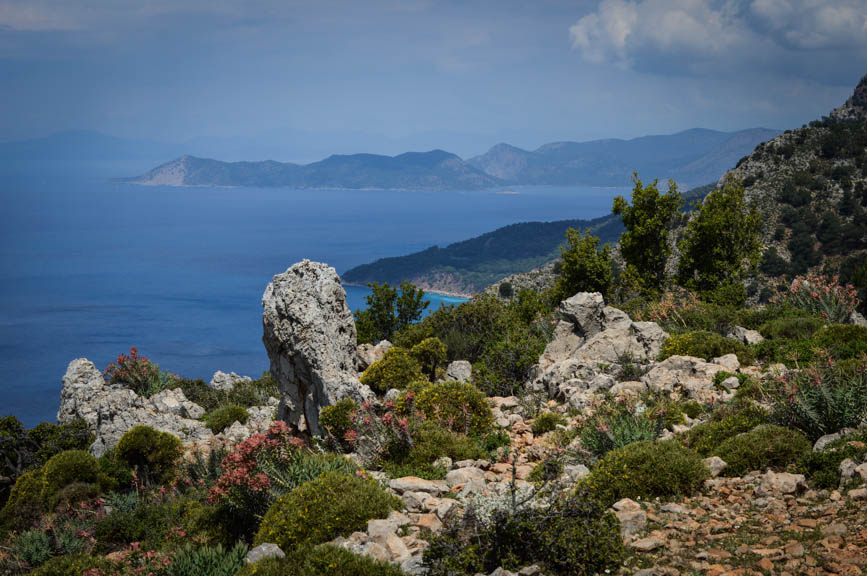
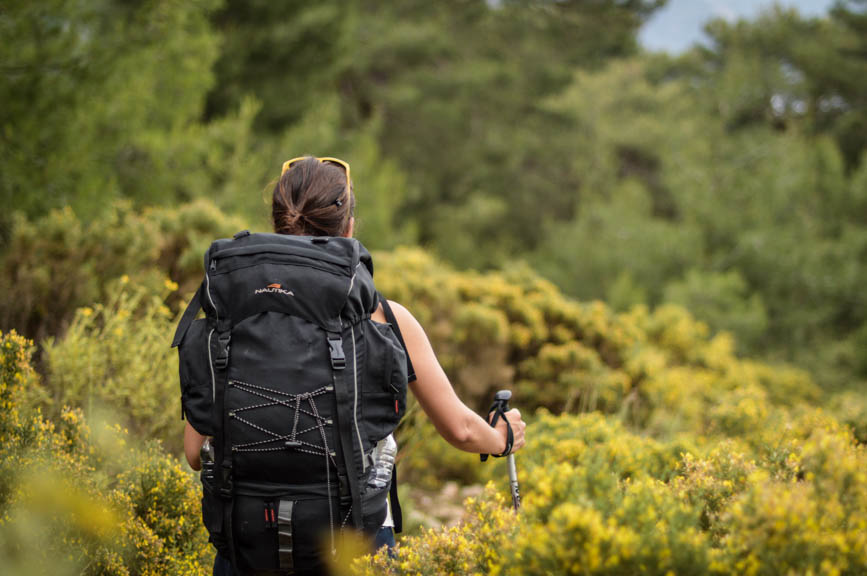
We continue onto Pidnei where we are suddenly jolted back to civilisation. The past few days included hamlets of not more than about 40 inhabitants, pretty much having the wilderness all to ourselves, here, we were greeted by rows and rows of greenhouses floating among the marshy waters of the Eşen river delta. We get a little lost searching for the white and red stripes among the old Lycian ruins that are still standing, encounter our first big snake, survive the encounter and finally arrive at the beach. A kind resident guides us to a rickety bridge across the marsh and a surprise awaits us on the other side.
A group of men having a BBQ in front of what seem like several old camper vans wave us over to join them. Initially we were unsure, but our curiosity leads us straight to them. Merrich, Ali, Saadi and the one they referred to as the “Playboy”, were having their sunday BBQ by the river and invited us to share their food. Shy at first, we politely nibbled, but a few moments later we could not resist the smell of the sizzling lamb and potatoes. They must have felt sorry for all of us as we voraciously dug in, kilometres of hiking with no lunch had left our appetites vulnerable to anything proposed and we gobbled up the fresh tomatoes, rucola (rucola!) and parsley sprayed with fresh lemon juice and sprinkled with salt. Most of the produce came from Merrich’s greenhouse, he proudly explained how it was all organic. I don’t know if it was the hunger speaking, but that rucola and those tomatoes were the best I have had in a long time.
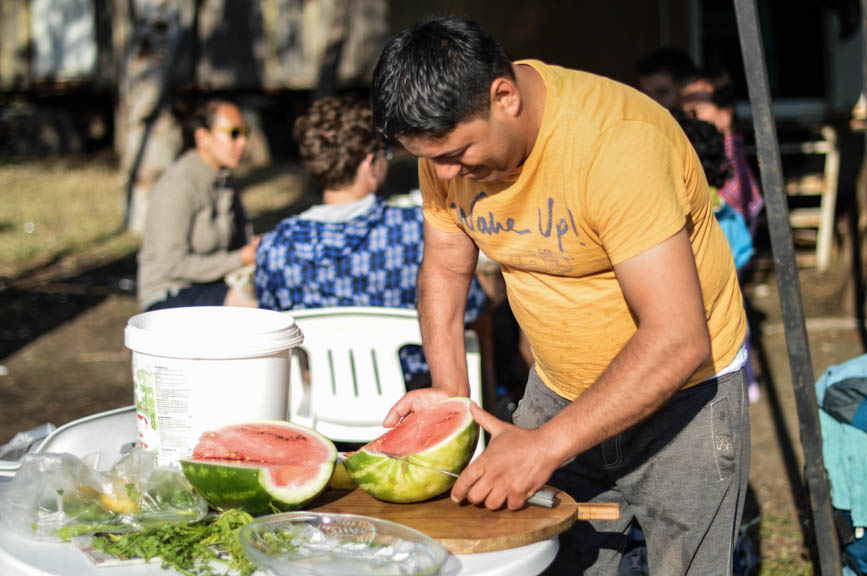
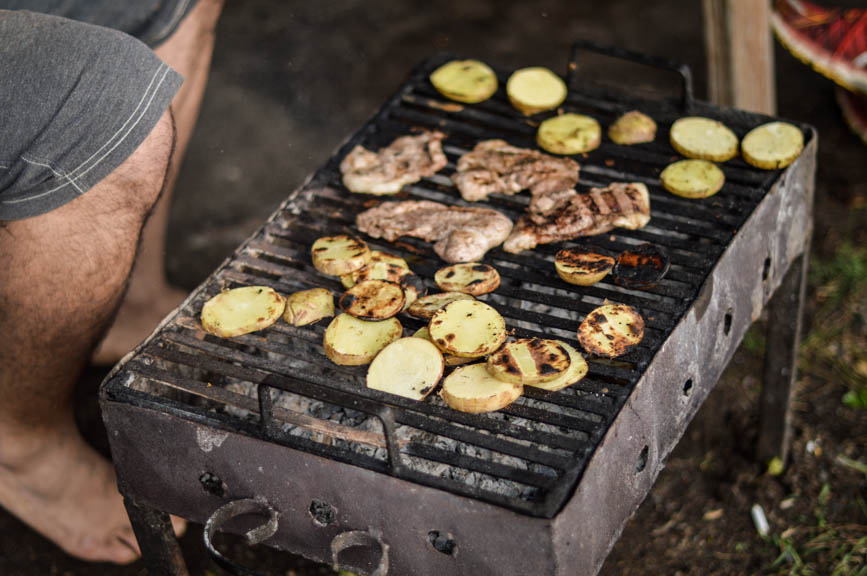
Abundant glasses of raki were passed around to down the meat and once again we are amazed at the hospitality we have encountered in Turkey so far. Without knowing us, Merrich and his friends fed a group of 4 hungry hikers for free and made our day. To top it all off, at one point someone emerged from their car with a huge watermelon to happy cheers.
At around 18H40, we dragged ourselves from all the merriment to make our way to our final destination for the day – Letoon. We said bye to Merrich’s group and L & S who were staying behind to camp on the beach, and pushed into the marsh for the last 12km.
Technically this was a bold or stupid choice depending on your interpretation.
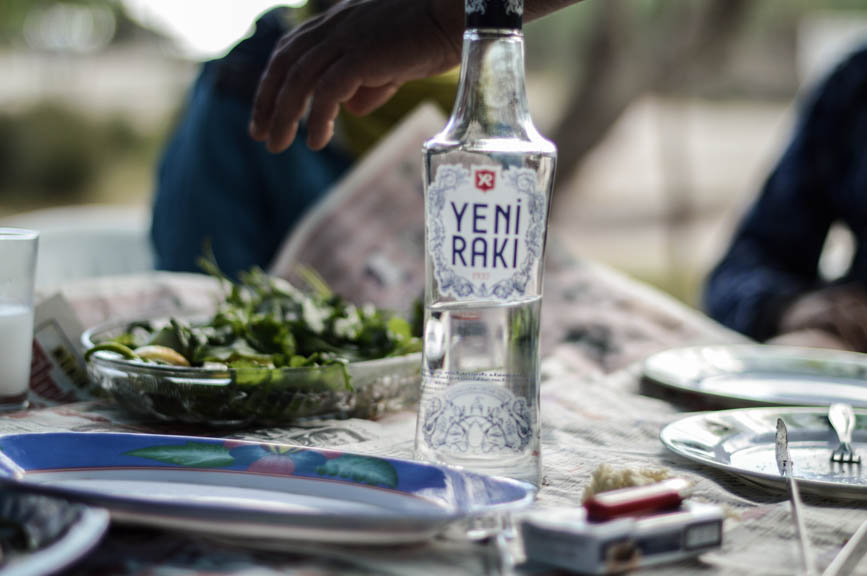

As the sun began turning an amber yellow, we tiptoed through swampy paths and dense vegetation to find accommodation before it got dark. Initially euphoric from the wonderful BBQ encounter and raki, we admired the changing landscape, the images before our eyes did not seem at all like the mountains we had come from, we were transported straight into an African savannah. Our euphoria began turning into slight panic when this marshland showed no signs of ending and the sun gradually got ready to tuck itself into bed. We quicken our pace and finally as darkness sets in we arrive in Letoon.
Never-ending greenhouses queue up to line the streets of Letoon as we keep an eye out for any signs of pansiyons or a friendly face to take us in. With the exception of a few aggressive dogs and children playing in the street there is no one. Not a soul and not a sign available. We continue walking, strategising on what we should do next until it becomes completely dark and the only lights on the street are the headlights of cars driving up and down. At one point we hear music and see lights, salvation! We make our way to the sound, hoping to find some kind of help when a farmer driving past stops his car and asks what on earth we are doing on the road in the dark at this time. We explain to him our mistake, thinking that there was accommodation and he tells us in surprisingly good english that no, no there are only farms here. He is kind enough to take us to the next town of Kinik since he is driving his mother home and drops us off at the bus station there.
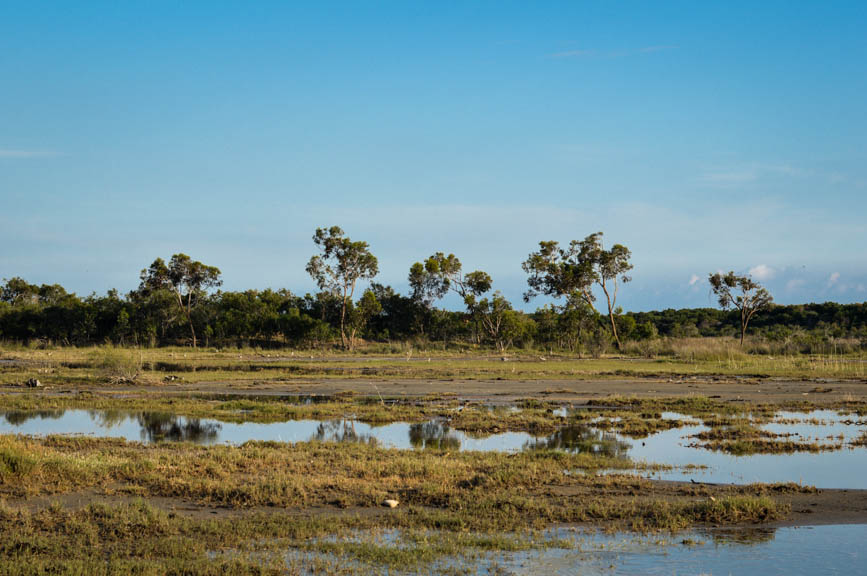
In Kinik the buses are no longer running and it is 9pm by now. There is no accommodation here either and our best bet is the nearby town of Gelemiş (Patara). A sympathetic telephone shop owner tells us to wait for him to close the store and he will drive us. Luckily an off-shift dolmus driver passes in front of the shop and says he will take us instead, sparing the telephone shop owner the extra drive. Not many places would have given us the confidence and security to hitchhike at night (not that we even had to ask here), but the kindness of the Turkish people so far left us with zero doubts and soon a series of events led us to the cozy little town of Gelemiş/Patara.
We left Bel that morning never expecting an adventure like this, nor expecting to end up in Patara that night, but that is the best part of following the unexpected and so far we have been lucky enough to be rewarded ten folds each time.
We spent the next few days relaxing and exploring the fascinating Lycian ruins in Patara – previously the capital of the Lycians and one of their most important ports until silt from the Eşen river made it unnavigable. You can roam among the ruins freely, without the customary packs of tour buses rumbling in, stepping back in time all by yourself. Patara is also home to the longest beach in the region stretching 18km along the coast, making it a great place to decompress. We decide to stop our trek here and move on to our next destination.
This trek will be remembered as our “luxury trek”. Usually these two words do not go naturally together, but after 5 days of adventure, mind-blowing and diverse views, almost-daily hot showers, fantastic food, occasionally dips in the ocean, meeting incredible people and having all of the above to ourselves, it was clear that we had been extremely spoilt.
We will definitely be back to hike through more of Turkey.
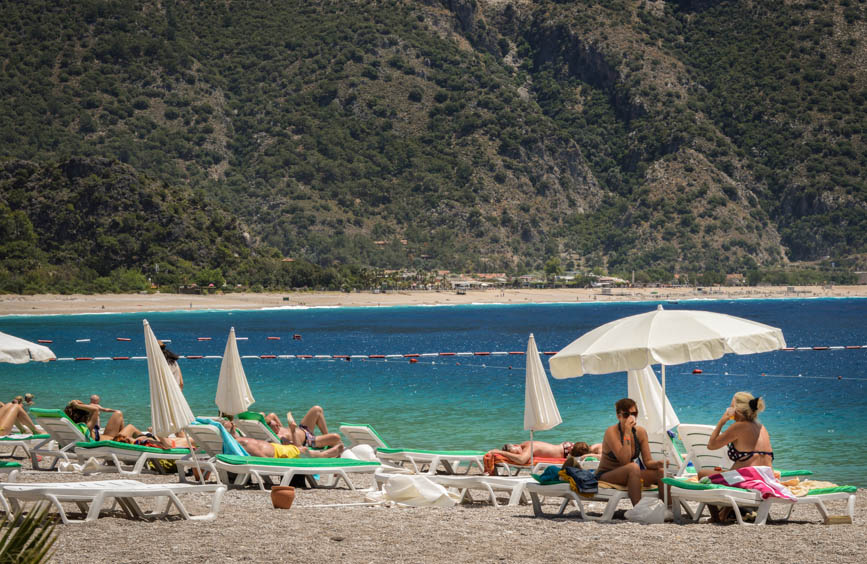
While we saw many beaches from above, on our last day back in Fethiye we visited the famous Olüdeniz beach from ground level. It is most likely the last beach we will see until south-east Asia since we will be crossing mainly landlocked countries until then, but what a beach to end on. With the same stunning colours we witnessed from above, plus or minus a few more tourists chasing the sun.






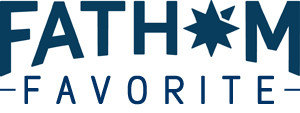
2 Comments
tammy
May 28, 2014Again such interesting adventure to read! Got me excited when you are stucked late at night etc. You are so lucky! Thank you for sharing!
Öms
June 1, 2014Good job! Kolay gelsin!